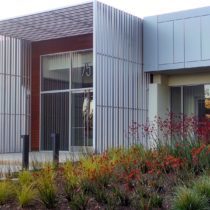Landscape Architecture for Landscape Architects › Forums › TECHNOLOGY › CAD – colored/rendered trees in plan and elevation and other blocks for graphics
- This topic has 1 reply, 7 voices, and was last updated 13 years, 3 months ago by
 Theodore Tegen.
Theodore Tegen.
-
AuthorPosts
-
December 29, 2010 at 12:47 am #166030
 Wes Arola, RLAParticipant
Wes Arola, RLAParticipantperfect thank you sir!
December 29, 2010 at 3:00 am #166029 Mike MitchellParticipant
Mike MitchellParticipantI have not used this program in a few years, but it seemed to work well for site plans.
http://www.aay.com/squiggle.htm
December 29, 2010 at 3:16 am #166028 Thomas J. JohnsonParticipant
Thomas J. JohnsonParticipantSketchUP Pro is very close to being able to replace AutoCAD for basic landscape design. I’m still playing with “Layout” but my initial impression is that it’s not quite there… it’s nice for simple layouts/presentations but being a separate application is a bit clumsy, creating planting/material schedules with symbols seems like it might be tough. Being able to show different “scenes” is pretty groovy. Overall SketchUP Pro has come a long way but still needs a few things before it replaces AutoCAD but it’s real close (take note AutoCAD).
For more robust and complicated landscape architecture BIM (LIM?) will be the future. I don’t understand people who don’t see the applicability of BIM in LA. If you are designing large sites it would be a huge time saver. The possibilities are endless. Huge plans with thousands of plants representing several different species could be tied to nursery suppliers in the project area confirming that your plants are available or automatically searching for stock from other suppliers. Plant counts could be automatically updated on the schedule as the plan changes. Plant data could be analyzed in the design and raise red flags (are you sure you want to plant that Jasmine on the north side of the building?) The plant data could also be tied into an irrigation design program, automatically selecting the best heads/settings to conserve water while meeting the needs of the plants. Site furnishings and hardscape could be tied to suppliers/manufacturers, automatically populating schedules and counts and construction details. Irrigation design would be a snap, the computer could do it for you (based on meter location, plant data and pressure) and provide water usage data for the designed system. BIM could also process the “sustainability” of a sites design, essentially eliminating the need for “people” to be LEED certified. The computer would automatically know the carbon footprint, recycled content, transportation and energy costs of any given product. BIM could also compute the run-off rates for a landscape design based on permeable vs. non-permeable surfaces, slopes, bio-swales/grading v.s. using drainage products, ensuring that the site meets best practice standards for storm water management (I bet SoCal wished they slowed their run-off instead of plumbing every square foot of a site and consistently trying to move water off-site, as fast as possible, in light of all the recent flooding.Then again maybe they are too oblivious to see the error of their ways… but that’s another story) BIM (LIM) has infinite applications for automating processes and analyzing site design. It will make the way we handle construction documents now look archaic. Old man voice – “Back when I started landscape architecture I had to count the number of planters on the site and manually type the manufacturers contact information and specifications into the materials schedule.”
December 29, 2010 at 4:06 am #166027 Steve MercerParticipant
Steve MercerParticipantHi Thomas,
I agree that SketchUP is getting close but it is not quite there yet for some tasks. The biggest issue I see with BIM (except from the way you describe it… it sounds like it will do everything including kiss my wife good nite for me. 🙂 just kidding of course. No seriously, who is going to create all of the 3d plant material required for LIM? That is the big stubbling block. So even if all the plant models were created LIM is just a stop on the way to L-nervana. Because of the nature of plants after they have been modeled and imported or designed into a LIM program are you going to be able to see these plants and what they are going to look like at any stage of growth and in any season? I see a program that the LIM model is imported to that is a simulated envrionment. So you could enter your gps co-ordinates of the site and the program would simulate the average percipitation, temperatures, light, etc. In this environment if a designer placed 3 pin oak trees 10′ apart, At install date assuming a 2″ caliper tree the tree heads would be symetrical however, after 5 simulated years the tree canopys would begin to grow together. And where that occured the software would be smart enough to realize that the light levels had dropped to a level where leaves would stop growing on those branches and then later those branches would die off on their own. The Designer could apply basic pruning rules to groups of plants, Hedges, espaliers etc. and the simulated growth evironment would apply those rules to the model. The Designer could catch design flaws before a single plant was planted. This type of program would lead to at least a shot a sustainable landscape based on averages for that location of course (probably can’t factor in the huricanes, mudslides, tornatos etc. etc. ( that is version to of the sim software LOL!).
s.
December 29, 2010 at 4:51 am #166026 Thomas J. JohnsonParticipant
Thomas J. JohnsonParticipantGenerally plants are drawn, in plan or perspective, at 3/4 mature size. Designs are not sold to the client depicting 2″ caliper trees with gator bags and guy-wires. We show what it will look like… Visualization is still, and always will be the designers job. Sure, it would be cool to see the whole site “grow” before your eyes in a 3D illustration but it’s not necessary to sell a project and doesn’t contribute to the design process. When you place the 3 Pin Oak symbols, 10′ O.C., in your plan with a 30′ canopy, the resulting image should be sufficient to alert you to a potential issue… either you need to specify a very rigorous pruning regiment (and make sure there’s the budget for it) or you need to give them more room… but you could probably figure all of that out in your head, or with a quick sketch… Complicated 3D plants, especially those that grow “intelligently”, are a waste for landscape architecture. You don’t need to have every variety of plant, with every leaf detailed in 3D. If anything, 3D plants should be simplified and emphasize form rather than detail. That is, unless you enjoy waiting for drawing to regenerate or render… They really don’t even need to be 3D, they just need to automatically “face” the viewer. For LIM, a 2D tree symbol could have a 3D tree form associated with it (conical, weeping, columnar, vase, globe, etc), so that you could design in 2D then orbit into 3D to see what it looks like… in case you can’t see it in your head or want to generate a quick perspective…
December 29, 2010 at 5:04 am #166025 Thomas J. JohnsonParticipant
Thomas J. JohnsonParticipantSweet! The latest version is compatible with AutoCAD 2006! 🙂
I hope he sold his “squiggle” code to AutoDesk for a nice chunk of dough.
December 29, 2010 at 5:24 am #166024 Steve MercerParticipant
Steve MercerParticipantUnfortunately that negates the whole idea of BIM to Start with. The whole point of BIM is place 3d componet design items in the Model and attach all the related database info to it. How can you accomplish that if you don’t have a 3d plant model for every plant used in BIM? It would be like building a multistory high rise and substituting 2×4′ for steel I-beams because you had not taken the time to draw the I beam componets yet. I don’t get it? My point with the sim software is that designers tend to overplant the landscapes. Perhaps if a tool like this was available it would help correct some of the bad habits that are out there in the designs.
s.
December 29, 2010 at 6:09 am #166023 Thomas J. JohnsonParticipant
Thomas J. JohnsonParticipantBuilding Information Modeling (BIM) Typically uses three-dimensional, real-time, dynamic building modeling software to increase productivity in building design and
construction.[2]
The process produces the Building Information Model (also abbreviated
BIM), which encompasses building geometry, spatial relationships,
geographic information, and quantities and properties of building components.To apply the geometry, spacial, geographic information, quantities and properties of a landscape plan does not require detailed 3D trees. You only need to associate a symbol with the plant information, or paving, site amenities, etc, etc. If you want 3D visualization you could have very simple, yet visually effective, 3D trees that emphasize mass and form. You could even have 2D trees, like those you would use in a Photoshop collage (entourage) that “turn” to face the viewer. SketchUP has trees like this.
As far as “over planting” there are many reasons to plant “too close”… immediate impact, anticipated failure of some plants and resultant thinning, desired effect… Versailles has sycamores planted 13 feet on center. They are HUGE and it works great.
Speaking of trees and BIM. I just read that they can predict the heating/cooling efficiency of a building by +/- 3% using BIM. I’m guessing that they are not factoring in the cooling effect of trees on a building… which, is huge! The difference between having a mature shade tree and not represents several degrees difference inside a building… plants can increase the efficiency of a building or what about a wind-screen blocking winter winds…
December 30, 2010 at 8:54 pm #166022 Steve MercerParticipant
Steve MercerParticipantHi Thomas,
As I understand it the one thing the Revit has no provisions to deal with is Curbs. And what about all of the civil stuff? That is still handled beter in AutoCad than anywhere else. Regardless of Autodesk’s desire for you to go and spend twice the money for Civil3D.
s.
December 30, 2010 at 9:07 pm #166021 Scott LebsackParticipant
Scott LebsackParticipantI’ve never had luck printing w/ transparency? tried on a few pools…
December 31, 2010 at 12:32 am #166020 ncaParticipant
ncaParticipantThere used to be a program called ‘MColor’ that did all this for you. EDAW used it at one point.
I prefer rendering in Adobe software.
-
AuthorPosts
- You must be logged in to reply to this topic.

